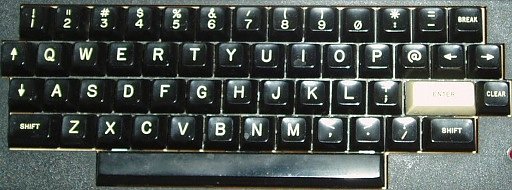Note: [esc]=[break] \=[clear]
This is using code for a javascript TRS-80 emulator from Peter Phillips at http://people.cs.ubc.ca/~pphillip/trs80.html.
To edit a line in basic type edit followed by the line number. After that space moves forward, backspace moves backward, enter exits the edit more, I goes to insert mode, and D deletes.
The cheat sheet below started with notes from Mike's Virtual Computer Museum at
http://www3.nbnet.nb.ca/mclays/level2.html.
ABS(X) Returns the absolute value of x.
CLOAD Loads a program from cassette tape.
CLS Clears the video screen.
CONT Continues program execution after BREAK or STOP.
CSAVE Records (saves) a program on cassette tape.
DATA Holds data to be read by a READ statement in a program.
END Ends program execution.
FOR-NEXT-STEP Sets up a program loop.
GOSUB Sends the program to a specified subroutine.
GOTO Causes program execution to jump to a specified line number.
IF-THEN Tests for a condition, specifes next action if condition is true.
INPUT Allows keyboard entry of data during program execution.
INPUT# Inputs data from a cassette tape.
INT(X) Returns the integer value of x.
LET Assigns a value to a variable.
LIST Displays a program in memory on the video display.
MEM Returns the number of free bytes of memory.
NEW Clears program from memory.
ON Multi-way program branch, used with GOTO or GOSUB.
POINT Tests to see if a specifed graphics point is turned on or off.
PRINT Displays information on the video screen.
PRINTAT Allows printing at a specified video screen location.
PRINT# Records data on the cassette tape.
READ Reads information from DATA statement in a program.
REM Add a remark to the program.
RESET Turns off a specified graphics point on the video display.
RESTORE Causes the next READ statement to start over at the beginning of
the DATA list.
RETURN Returns program to its original sequence after subroutine execution.
RND(1) Generates a random number >0 and <1.
RND(X) Generates a random number >1 and <=x.
RUN Starts program execution.
SET Lights up a specified graphics point on the video display.
STOP Stops program execution.
TAB Begins printing at a specified number of spaces from the left
margin of the video screen.
ASC(A$) Returns ASCII code for first character of A$.
ATN(X) Returns the arctangent of X in radians.
AUTO Turns on the automatic line numbering feature. There was a
utility available under TRSDOS that allowed the renumbering
of BASIC programs.
CDBL(X) Convert a value to double precision.
CHR$(X) Returns the ASCII character represented by the code x.
CINT(X) Converts value to Integer precision.
CLEAR Clears variables from memory.
CLEAR(X) Reserves string variable space.
CLOAD"FILE" Loads named file from cassette tape.
CLOAD? Verifies program saved to cassette tape by re-reading it and
comparing it to the copy in memory.
COS(X) Returns the cosine, in radians.
CSAVE"FILE" Saves the program in memory to a cassette tape.
CSNG(X) Converts to single precision.
DEFDBL Defines specified variables as double precision.
DEFINT Defines specified variables as integer precision.
DEFSNG Defines specified variables as single precision.
DEFSTR Defines specified variables as strings.
DELETE Deletes specified lines in the current program.
DIM Reserves space for arrays.
EDIT Enters edit mode. This let you interactivly edit a line of BASIC
code without having to re-enter it.
ELSE Used to direct execution to an alternate branch if the condition
specified by the IF was not met.
ERL Returns the line number of the last error encountered.
ERR Returns the error number of the last error encountered.
ERROR(X) Generates error number x.
EXP(X) Raises e to the power of x.
FIX(X) Truncates x (drops the decimal portion).
FRE(A$) Returns the amount of free string space available.
FRE(0) Returns the amout of free memory that is available.
INKEY$ Inputs a string value without pausing the program. Used in loops
to catch a keystroke while performing other functions.
INP(X) Inputs one byte from port number x.
INPUT#-1 Inputs data from casette tape unit #1
LEN(A$) Returns the length of A$.
LEFT(A$,n) Returns the leftmost n characters of the string A$.
LLIST Lists program to the line printer.
LOG(A) Returns the natural log of a.
LPOS(0) Returns the current position of the line printer head, in terms
of characters.
LPRINT Prints to the line printer.
MID$(A$,F,L) Returns characters F thru L of the string A$.
OUTx,y Outputs byte y to port x.
PEEK(X) Returns the contents of memory location x.
POKEx,y Puts byte y into memory location x.
POS(0) Returns the postion of the cursor on the video display.
PRINT@ Prints at a specified screen postion.
PRINTUSING Prints data according to a specified format string.
RANDOM Randomizes the random number generator.
RESUME Returns from an ON-ERROR-GOTO trap.
RIGHT(A$,N) Returns the last n characters of the string A$.
SGN(X) Returns 1 if x.gt.0, 0 if x=0, and -1 if x.lt.0.
SIN(X) Funtion that returned the sine of angle x, in radians.
SQR(X) Returns the square root of x.
STR$(X) Function to convert the number x to a numeric string.
STRING$(N,A$) Function that returns a string of n copies of the
single character contained in A$.
SYSTEM Places the TRS-80 in a mode that will allow the loading of a
machine language program from cassette tape.
TAN(X) Function to return the tangent of angle x, in radians.
TRON Initiates trace mode.
TROFF Disables trace mode.
USR(0) allows access to machine language subroutine.
VAL(A$) Function that converts a numeric string to a number.
VARPTR(X) Funtion that returns the address where variable x is
stored in memory.

